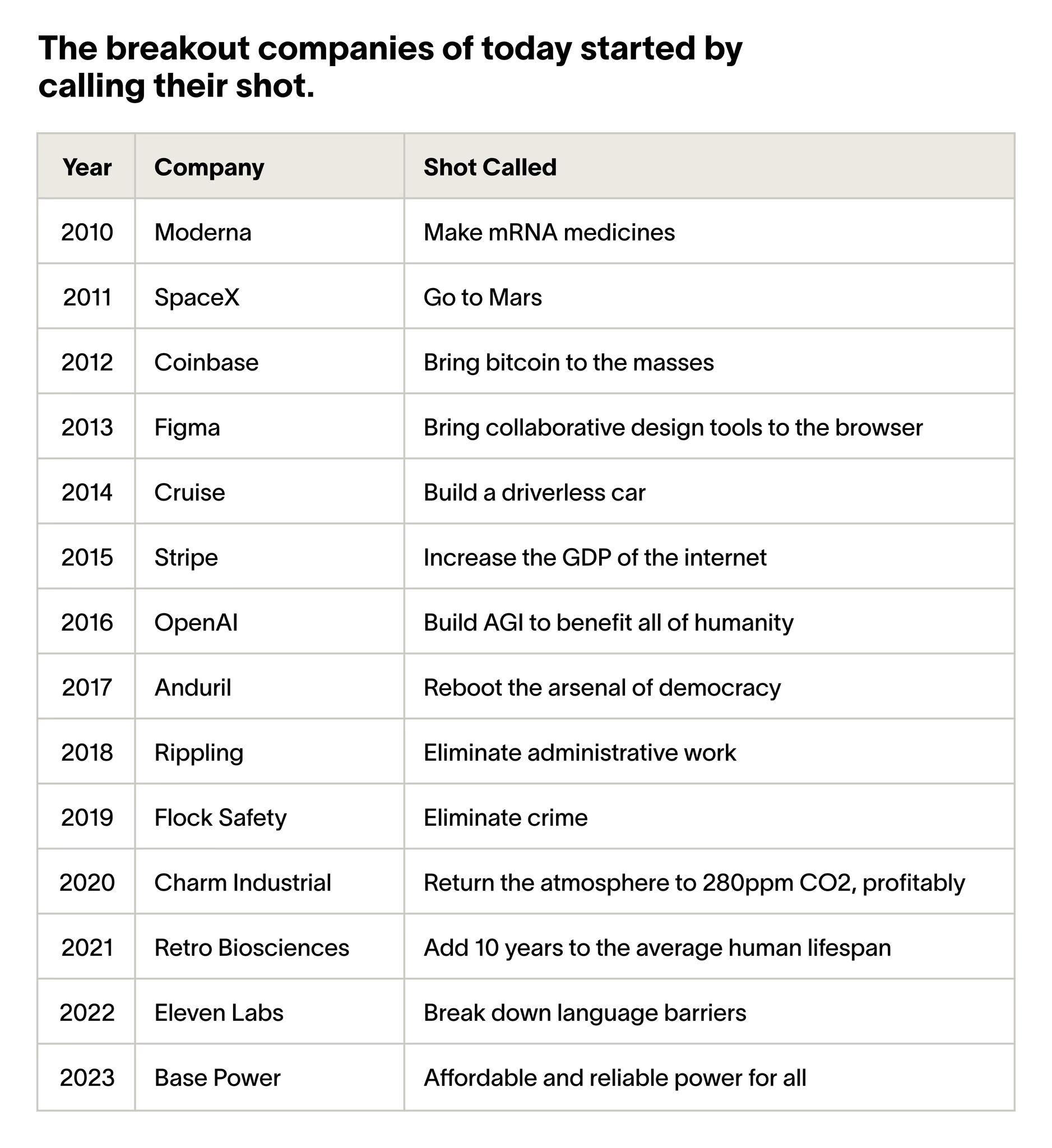

The collapse of two banks — Bear Stearns in March 2008 and Silicon Valley Bank in March 2023 — marks the ceremonial beginning and end of the most recent cycle in startup history. If that 15-year era was defined by increasingly standardized and tracked methods of building startups, this one is being defined by the opposite: founders who are intentional in their pursuit of specific goals with high stakes.
Today we are announcing Terrain, an early-stage investment firm purpose-built to back these founders. Our first investment is in Base Power which this week announced $68m in funding (Update: As of April 2025 Base Power announced an additional $200m of funding). We’ve made other investments in areas such as developer platforms, longevity, crypto, and AI infrastructure.
Prior to Terrain, we invested in early-stage startups, built software products at scale, and were founders. Eric has made venture and/or personal investments in companies like Flock Safety, Figma, Lattice, Plaid, Homebase, and Check. Willem partnered to incubate companies such as The Browser Company, Cadence, and Imprint.
Together we believe there is a better way to build startups for this era. We’ve started Terrain to back founders who believe the same.
- Eric Stromberg and Willem Van Lancker
Call Your Shot
I. Dawn of the Startup Generation
If you tried to pinpoint the day the modern era of startups began, one good answer would be March 16, 2008: when Bear Stearns failed. Why?
Before then, the default career track for America’s brightest was Wall Street. Investment banking, private equity, hedge funds, maybe consulting…with a cup of tea at business school along the way.
On The Wall Street Track, you’d enjoy money and status. Every Fall, recruiters from top firms descended on college campuses. They put out the word, and filled hotel ballrooms like rock stars. Summer interns dined at New York’s finest restaurants. Salaries climbed…but not as fast as the cottage industry of consultants that would help you get on The Track. If accepted, you’d work with people who exuded a bravado previously reserved for celebrities and imagine that one day it could be you. The Track took America’s best on a magic carpet ride that ended on Wall Street — with little concern for whether they should be there.
That all changed after March 16, 2008.
Offers were rescinded. Bonuses evaporated. Fine dining was replaced with a $20 food delivery allowance…if you stayed past 7pm. Your friends Occupied Wall Street and said you were the problem. Money and status went poof.
What would replace this coveted track?
II. The Startup Track
Just as The Wall Street Track broke, a new one emerged: The Startup Track. Before 2008, nobody knew how to build a startup. Maybe not literally nobody, but the number was small and they all lived within 10 miles of Stanford. Starting a company was low status; assumed to be for those who couldn’t get a real job. It required an extreme person on an even more extreme mission. There was no track to follow.
That soon changed. Talent was unleashed from The Wall Street Track just as the technology world hit its stride. In 2004 Google went public and Facebook was founded. By 2008 both were soaring; delivering startups as a viable career path for the nation’s best. In 2010 the movie The Social Network brought The Startup Track into global consciousness: Start a company and be like Zuck. Like railroad tracks built across America in the 1800s, economic tracks were laid in the 2010s to support demand for startups. Accelerators to help you start. Venture funds to help you scale. Blog posts. Dinners. Conferences. More each year.
All with good intentions.
In time, what started as an earnest effort to help founders avoid mistakes grew into something different — and dramatically lowered the perceived risk of startups. One track became hundreds, each promising a more predictable path to success. Tracks for founders. Tracks for employees. Tracks for venture capitalists. Longer Playbooks. Bigger roundtables. Wider Market Maps. Specialized tracks for SaaS startups. For marketplaces. For SaaS-enabled marketplaces. For SaaS-enabled marketplaces in the logistics industry. Yes, we definitely have that playbook.
Dependent on the tracks for their livelihood, thought leaders and VCs alike manifested more. Singular breakout companies — it was believed — would lay new tracks for others to follow. Facebook would spark hundreds of vertical social networks — for sports…for education…for fitness. Airbnb, Uber, and Shopify would bring us wholly new economies! The sharing one, the on-demand one, and the creator one. OpenAI’s breakthrough would lead to verticalized LLMs — one for every industry. A very comforting thought — if you miss investing in a winner, that’s nothing compared to the hoards behind them on the track. For VCs, allocating to a popular track felt risk-free. Follow-on investors would invest in the same one!
The Lean Startup told you to take your big idea and make it small. Product/market fit is a science. A formula. Math, if you will. If it’s a disaster, you can pivot. There’s no way to fail because you don’t even know what you are building. And nobody likes the possibility of failure, least of all anyone who has signed up for a track.
The message was clear: Just get on The Track and pick a general direction...you’ll eventually get there…or you’ll get somewhere.
Like a river with a strong current, it was believed, the power of The Track — not the individual founder or mission – could propel a company forward.
And for a brief moment it looked that way.
III. Cracks in the Tracks
By 2021, one might argue that The Track had grown into a sprawling apparatus that served itself more than the founders at the heart of the ecosystem. Startups were sold as a prestigious career track with set milestones and rewards — like being a banker, consultant or tech executive.
It was déja vu all over again. Founders that neatly fit on The Track were courted by VCs at the finest SF restaurants. Valuations climbed…but not as fast as the cottage industry of coaches that helped you manage your ballooning headcount. If accepted, you’d join VC retreats with unicorn CEOs who exuded a bravado previously reserved for celebrities and imagine one day it could be you. Indeed, more than a few founders were taken on a magic carpet ride to raise more capital… with little concern for if they should.
In 2022 the market crashed…and The Startup Track went with it. Fundraising was harder. Layoffs proliferated. Interest rates rose and multiples compressed. Belief went from abundant to scarce. What once seemed to be a predictable path was revealed as more idiosyncratic. If it wasn’t already clear by March 10, 2023, the collapse of Silicon Valley Bank sent a clear message that echoed Bear Stearns 15 years earlier: The Startup Track is over.
Outside of a narrow bubble in AI, there is a growing skepticism of The Startup Track — from founders, investors, and employees alike. The unease of not having a predictable track is palpable. Some have filled the void by rolling up HVAC businesses. Others have sworn to stay independent forever. Or maybe it’s one round and done. That’s the new formula. No, you must have misheard – with AI the playbook is one person creating a one billion dollar outcome. Maybe you just need to be in SF. Or is it the Gundo.
Or maybe you can find success in all of them...or in none of them. Maybe there are no generalizable startup tracks, and there never have been.
IV. Call your Shot
Today, something more powerful than The Track has emerged, driven by a set of companies who rejected it. Instead of jumping on The Track and letting it take them somewhere, they have the agency and determination to map exactly where they are going. They pursue specific goals, not generic themes. The stakes aren’t about fighting for market share but fighting for the future.
At or near founding, these leaders point to a specific point... far on the horizon... that shows us all the shape of the future. They then work intently — day by day, year after year — to forge a path between today’s reality and their vision.
They call their shot.

This is a fundamentally different way to start. It also stands in stark contrast to a sea of vague missions from tech giants today. Take one whose mission is “revolutionizing commerce globally.” Is this eBay, Paypal, GoDaddy, Adyen, Wix, or Squarespace? Or none of them? Another is “make commerce better for everyone.” How will employees know if their mission has succeeded or failed? Perhaps that is the point. In 2008 big banks were thought to be too Too Big to Fail. Today, big tech has become Too Bland to Fail. This is the startup opportunity.
Those who call their shot put a stake in the ground. They may succeed. They may fail. But there is no ambiguity about if they delivered on their one shot. Bright lines around success and failure serve an important purpose: they drive focus, alignment, and rally others to their cause. It forces everyone to face the stakes of a mission that is not open to interpretation. In turn, the specificity leaves far less room for the mission to be hijacked for a different one.
Often, these companies have an assembly phase before launch. Figma famously built their product for four years prior to releasing it broadly. If the tracked era swung the pendulum toward launch fast and iterate, these founders are pushing back. Instead, they set their foundation intentionally – focusing an extensive period of time on building the right product, identifying the right customer, and attracting the right resources to pursue their goal.

For tracked companies, the stakes are sold as market share. A wave is coming and we can capitalize on it. VR. Remote work. NFTs. The rallying cry is, “If we don't build it now, somebody else will.” In contrast, when you call your shot the stakes are the future. The belief is, “If we don't build it now, nobody else will.” This is powerful, and makes these companies a magnet for the best employees, investors, and customers.
There is no better example of this than SpaceX. At a time when most were obsessed with Occupy Wall Street, Elon Musk turned our attention to Occupy Mars (which promptly went on a t-shirt and became a wardrobe staple for every 10x engineer). That goal has propelled SpaceX. Today they have the best shot at reaching Mars of anyone on this planet — and have built a phenomenal business along the way:

What all of these companies leave in their wake may look like a track. And surely many will try to follow them thinking that it is. But they will all be disappointed. For each of these companies is singular — their success driven by the power of pursuing a specific goal with high stakes.
V. Point to the Possible
Today, cynicism runs rampant. We are told daily that threats of automation, inflation, bureaucracy, isolation, war, and climate change will upend our lives. On an industry level, we are exiting an exuberant period that has left many with a natural bend toward skepticism over optimism. If we needed a more obvious cue that a new era has begun, Aaron Sorkin just announced he is making a sequel to The Social Network to set the record straight: We all got it wrong. Facebook and tech are definitely not the hero of the story.
Against this backdrop, The Startup Track has no shot. As we exit a 15-year bull run, its power is diminished and novelty worn off. For many, it is the source of cynicism, not the antidote to it. Instead, to move men and women to action today requires a specific goal with high stakes — championed by founders who point to the possible. As the world searches for belief, they will find it in these companies. At first, they capture our attention as we all wonder, “How will they do that?” We are then drawn to participate in the story as their visions unfold — year after year, decade after decade — in front of us.
Collectively, these founders take our gaze from the glidepath of the present and point it toward the catalysts of the far future. They push our imagination — toward a world on the other side of AGI, or driverless cars, or where every person lives 10 years longer. They make us question our assumptions and envision new possibilities on the other side of these breakthroughs. They have the power to make us all more optimistic…more ambitious…more creative. They can take a generation gripped in a nihilistic spiral and inspire them toward something far more powerful.
Indeed, building a company that matters can only come from the strength of the individual and the power of their mission — not the strength of The Track. For the most significant endeavors, you must call your shot and forge a path on new terrain.